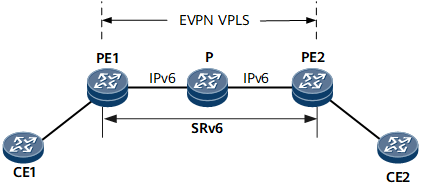Configuring EVPN VPLS over SRv6 BE
When the EVPN E-LAN model is used to carry multipoint-to-multipoint (MP2MP) VPLSs, EVPN VPLS over SRv6 BE can be configured to transmit EVPN E-LAN data over public SRv6 BE paths.
Usage Scenario
EVPN VPLS uses the EVPN E-LAN model to carry MP2MP VPLSs. EVPN VPLS over SRv6 BE uses public SRv6 BE paths to carry EVPN E-LAN services. The implementation of EVPN VPLS over SRv6 BE involves establishing SRv6 BE paths, advertising EVPN routes, and forwarding data.
As shown in Figure 1, PE1 and PE2 communicate through an IPv6 public network. SRv6 BE is deployed on the public IPv6 network to carry EVPN E-LAN services.
Pre-configuration Tasks
Before configuring EVPN VPLS over SRv6 BE, complete the following tasks:
Configure basic IPv6 IS-IS functions on PEs and the P.
Configure BD-EVPN functions on PEs.
Procedure
- Establish a BGP EVPN peer relationship between PEs.
- Configure basic SRv6 functions.
- Enable IS-IS SRv6.
- Configure EVPN routes to carry SIDs and recurse to SRv6 BE paths based on the SIDs.
Verifying the Configuration
After configuring EVPN VPLS over SRv6 BE, verify the configuration.
Run the display segment-routing ipv6 local-sid { end-dt2u | end-dt2ul | end-dt2m } [ sid ] [ bridge-domain bd-id ] forwarding command to check information about the SRv6 BE local SID table.
Run the display bgp evpn { all | route-distinguisher route-distinguisher | vpn-instance vpn-instance-name } routing-table [ { ad-route | es-route | inclusive-route | mac-route | prefix-route } prefix ] command to check BGP EVPN route information.
